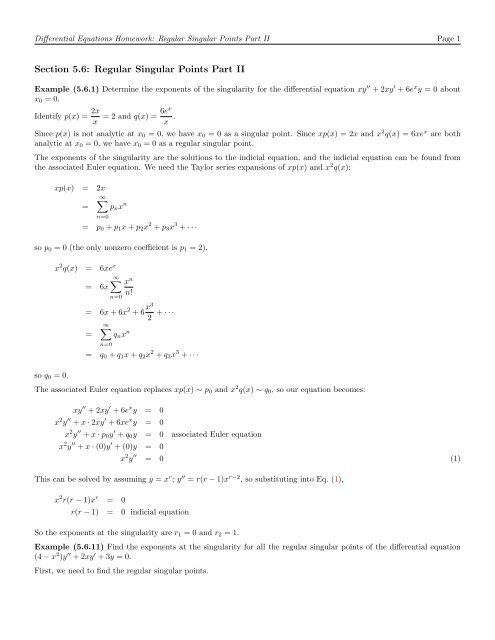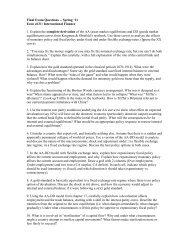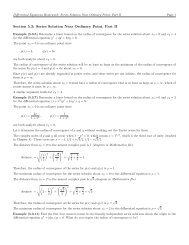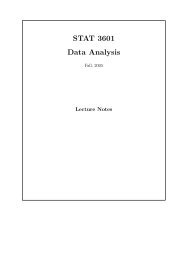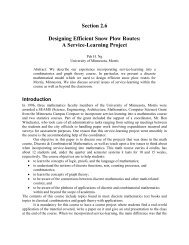Section 5.6: Regular Singular Points Part II
Section 5.6: Regular Singular Points Part II
Section 5.6: Regular Singular Points Part II
You also want an ePaper? Increase the reach of your titles
YUMPU automatically turns print PDFs into web optimized ePapers that Google loves.
Differential Equations Homework: <strong>Regular</strong> <strong>Singular</strong> <strong>Points</strong> <strong>Part</strong> <strong>II</strong> Page 1<br />
<strong>Section</strong> <strong>5.6</strong>: <strong>Regular</strong> <strong>Singular</strong> <strong>Points</strong> <strong>Part</strong> <strong>II</strong><br />
Example (<strong>5.6</strong>.1) Determine the exponents of the singularity for the differential equation xy ′′ + 2xy ′ + 6e x y = 0 about<br />
x0 = 0.<br />
Identify p(x) = 2x<br />
x<br />
= 2 and q(x) = 6ex<br />
x .<br />
Since p(x) is not analytic at x0 = 0, we have x0 = 0 as a singular point. Since xp(x) = 2x and x 2 q(x) = 6xe x are both<br />
analytic at x0 = 0, we have x0 = 0 as a regular singular point.<br />
The exponents of the singularity are the solutions to the indicial equation, and the indicial equation can be found from<br />
the associated Euler equation. We need the Taylor series expansions of xp(x) and x 2 q(x):<br />
xp(x) = 2x<br />
=<br />
∞<br />
pnx n<br />
n=0<br />
= p0 + p1x + p2x 2 + p3x 3 + · · ·<br />
so p0 = 0 (the only nonzero coefficient is p1 = 2).<br />
so q0 = 0.<br />
x 2 q(x) = 6xe x<br />
= 6x<br />
∞<br />
n=0<br />
x n<br />
n!<br />
= 6x + 6x 2 + 6 x3<br />
=<br />
∞<br />
qnx n<br />
n=0<br />
2<br />
+ · · ·<br />
= q0 + q1x + q2x 2 + q3x 3 + · · ·<br />
The associated Euler equation replaces xp(x) ∼ p0 and x 2 q(x) ∼ q0, so our equation becomes:<br />
xy ′′ + 2xy ′ + 6e x y = 0<br />
x 2 y ′′ + x · 2xy ′ + 6xe x y = 0<br />
x 2 y ′′ + x · p0y ′ + q0y = 0 associated Euler equation<br />
x 2 y ′′ + x · (0)y ′ + (0)y = 0<br />
x 2 y ′′ = 0 (1)<br />
This can be solved by assuming y = x r ; y ′′ = r(r − 1)x r−2 , so substituting into Eq. (1),<br />
x 2 r(r − 1)x r = 0<br />
r(r − 1) = 0 indicial equation<br />
So the exponents at the singularity are r1 = 0 and r2 = 1.<br />
Example (<strong>5.6</strong>.11) Find the exponents at the singularity for all the regular singular points of the differential equation<br />
(4 − x 2 )y ′′ + 2xy ′ + 3y = 0.<br />
First, we need to find the regular singular points.
Differential Equations Homework: <strong>Regular</strong> <strong>Singular</strong> <strong>Points</strong> <strong>Part</strong> <strong>II</strong> Page 2<br />
Identify p(x) = 2x 2x<br />
=<br />
4 − x2 (2 − x)(2 + x)<br />
and q(x) =<br />
3<br />
3<br />
=<br />
4 − x2 (2 − x)(2 + x) .<br />
Since p(x) is not analytic at x0 = ±2, we have x0 = ±2 as singular points. These are also the singular points for q(x).<br />
Consider x = +2:<br />
Since (x − 2)p(x) = − 2x<br />
2 + x and (x − 2)2 3(x − 2)<br />
q(x) = −<br />
2 + x are both analytic at x0 = +2, we have x0 = +2 as a regular<br />
singular point.<br />
Consider x = −2:<br />
Since (x + 2)p(x) = 2x<br />
2 − x and (x + 2)2q(x) =<br />
singular point.<br />
3(x + 2)<br />
2 − x<br />
are both analytic at x0 = −2, we have x0 = −2 as a regular<br />
OK, now we need to determine the exponents at the singularity for each regular singular point.<br />
Consider x = +2:<br />
The exponents of the singularity are the solutions to the indicial equation, and the indicial equation can be found from<br />
the associated Euler equation. We need the Taylor series expansions of (x − 2)p(x) and (x − 2) 2 q(x):<br />
(x − 2)p(x) = − 2x<br />
2 + x<br />
so p0 = −1.<br />
so q0 = 0.<br />
= −1 − 1 1<br />
(x − 2) +<br />
4 16 (x − 2)2 + · · · Taylor series about x0 = −2<br />
= p0 + p1(x − 2) + p2(x − 2) 2 + p3(x − 2) 3 + · · ·<br />
(x − 2) 2 3(x − 2)<br />
q(x) = −<br />
2 + x<br />
= 0 − 3 3<br />
(x − 2) +<br />
4 16 (x − 2)3 − · · · Taylor series about x0 = −2<br />
= q0 + q1(x − 2) + q2(x − 2) 2 + q3(x − 2) 3 + · · ·<br />
The associated Euler equation replaces (x − 2)p(x) ∼ p0 and (x − 2) 2 q(x) ∼ q0, so our equation becomes:<br />
(4 − x 2 )y ′′ + 2xy ′ + 3y = 0<br />
y ′′ 2x<br />
+<br />
(2 − x)(2 + x) y′ 3<br />
+<br />
y<br />
(2 − x)(2 + x)<br />
= 0<br />
(x − 2) 2 y ′′ 2x<br />
+ (x − 2) · (x − 2)<br />
(2 − x)(2 + x) y′ + (x − 2) 2 3<br />
y<br />
(2 − x)(2 + x)<br />
= 0<br />
(x − 2) 2 y ′′ − (x − 2) · 2x<br />
2 + x y′ 3(x − 2)<br />
− y<br />
2 + x<br />
= 0<br />
(x − 2) 2 y ′′ + (x − 2)p0y ′ + q0y = 0 associated Euler equation<br />
(x − 2) 2 y ′′ + (x − 2)(−1)y ′ + (0)y = 0<br />
(x − 2) 2 y ′′ − (x − 2)y ′ = 0 (2)<br />
This can be solved by assuming y = (x − 2) r ; y ′ = r(x − 2) r−1 , y ′′ = r(r − 1)(x − 2) r−2 , so substituting into Eq. (2),<br />
(x − 2) 2 r(r − 1)(x − 2) r−2 − (x − 2)r(x − 2) r−1 = 0<br />
r(r − 1) − r = 0 indicial equation<br />
r(r − 2) = 0
Differential Equations Homework: <strong>Regular</strong> <strong>Singular</strong> <strong>Points</strong> <strong>Part</strong> <strong>II</strong> Page 3<br />
So the exponents at the singularity x0 = −2 are r1 = 0 and r2 = 2.<br />
Consider x = −2:<br />
The exponents of the singularity are the solutions to the indicial equation, and the indicial equation can be found from<br />
the associated Euler equation. We need the Taylor series expansions of (x + 2)p(x) and (x + 2) 2 q(x):<br />
(x + 2)p(x) =<br />
so p0 = −1.<br />
so q0 = 0.<br />
(x + 2) 2 q(x) =<br />
2x<br />
2 − x<br />
= −1 + 1 1<br />
(x + 2) +<br />
4 16 (x + 2)2 + · · · Taylor series about x0 = +2<br />
= p0 + p1(x + 2) + p2(x + 2) 2 + p3(x + 2) 3 + · · ·<br />
3(x + 2)<br />
2 − x<br />
= 0 + 3 3<br />
(x + 2) +<br />
4 16 (x + 2)3 − · · · Taylor series about x0 = +2<br />
= q0 + q1(x + 2) + q2(x + 2) 2 + q3(x + 2) 3 + · · ·<br />
The associated Euler equation replaces (x + 2)p(x) ∼ p0 and (x + 2) 2 q(x) ∼ q0, so our equation becomes:<br />
(4 − x 2 )y ′′ + 2xy ′ + 3y = 0<br />
y ′′ 2x<br />
+<br />
(2 − x)(2 + x) y′ 3<br />
+<br />
y<br />
(2 − x)(2 + x)<br />
= 0<br />
(x + 2) 2 y ′′ 2x<br />
+ (x + 2) · (x + 2)<br />
(2 − x)(2 + x) y′ + (x + 2) 2 3<br />
y<br />
(2 − x)(2 + x)<br />
= 0<br />
(x + 2) 2 y ′′ + (x + 2) · 2x<br />
2 − x y′ 3(x + 2)<br />
+ y<br />
2 − x<br />
= 0<br />
(x + 2) 2 y ′′ + (x + 2)p0y ′ + q0y = 0 associated Euler equation<br />
(x + 2) 2 y ′′ + (x + 2)(−1)y ′ + (0)y = 0<br />
(x + 2) 2 y ′′ − (x + 2)y ′ = 0 (3)<br />
This can be solved by assuming y = (x + 2) r ; y ′ = r(x + 2) r−1 , y ′′ = r(r − 1)(x + 2) r−2 , so substituting into Eq. (3),<br />
(x + 2) 2 r(r − 1)(x + 2) r−2 − (x + 2)r(x + 2) r−1 = 0<br />
r(r − 1) − r = 0 indicial equation<br />
r(r − 2) = 0<br />
So the exponents at the singularity x0 = −2 are r1 = 0 and r2 = 2.<br />
If we can remember the following form, we can get the indicial equation directly from F (r) = r(r − 1) + p0r + q0, which<br />
is the from of the indicial equation for the associated Euler equation. If we forget it, we can use the process described in<br />
the solutions to create and solve the associated Euler equation.


